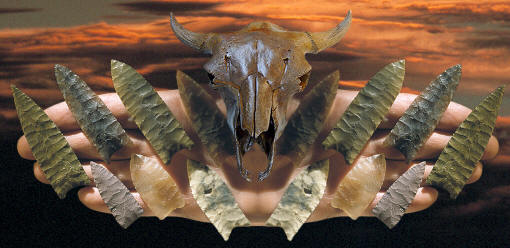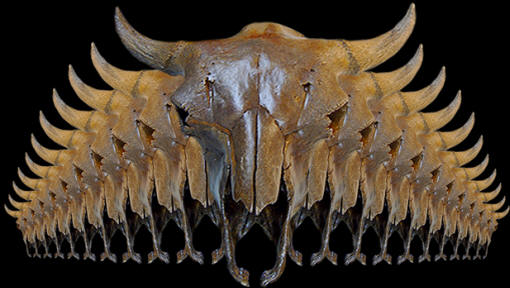|
"The
identification of a Goshen culture complex on the High Plains provided
Paleoindian archaeologists with a category in which to place a number of
possible diagnostic projectile points from this region that heretofore
were considered as Plainview, as it was known and described at the site
in Texas by that name."---1996,
George C. Frison, "The Mill Iron Site," p. 205.
"In order to illustrate better the dilemma
encountered in trying to distinguish between Goshen and Plainview
diagnostics, it is of more than passing interest to take exact casts of
both the Mill Iron and Plainview site points, mix them together, and
then attempt to separate the two assemblages on the basis of technology
and morphology."---1996,
George C. Frison, "The Mill Iron Site," p. 207.
"The Goshen
Paleoindian cultural complex was first recognized at the Hell Gap site
in Goshen County, southeastern Wyoming, in the early 1960's"---1991,
George C. Frison, "The Goshen Paleoindian Complex: New Data For
Paleoindian Research," Clovis Origins And Adaptations, p.
133.
"Goshen points have been reported from other
Northern Plains sites such as Jim Pitts, South Dakota, and Lower Twin
Mountain in Middle Park of the Colorado Rockies."---2006,
Bruce B. Huckell And W. James Judge, "Paleo-Indian: Plains And
Southwest," Handbook Of North American Indians, Vol. 3,
Environment, Origins, And Population, p. 158.
"Radiocarbon dates from the Mill Iron site
cluster at two different times, 11,360 & 10,840 radio carbon years
before present, which could mean Goshen has a Clovis and a Folsom age."---2002,
Gary Haynes,
"The Early Settlement Of North America, The Clovis Era," p.
257.

GOSHEN POINTS &
THE MILL IRON SITE
MILL
IRON SITE
CARTER COUNTY, MONTANA
The Mill Iron site is located in southwestern Montana about 7.5 miles
from the town of Mill Iron, from where it receives its name. The Mill Iron site was discovered in 1979 during a
survey of Bureau of Land Management land prior to reservoir construction. George Frison was
director of the excavation from 1984 to 1988 when the project officially
ended in August. Most of the workers were volunteers and funding was
provided by the Bureau of Land Management, National Geographic Society
and the National Science Foundation.
|
|
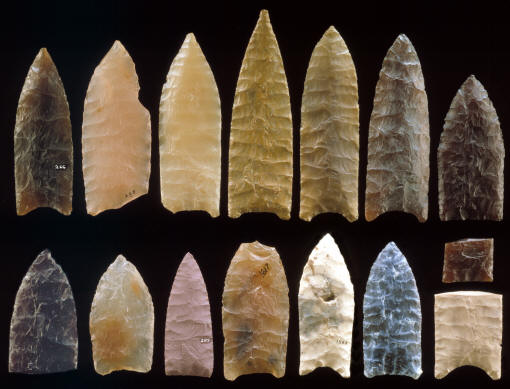
EPOXY CASTS OF GOSHEN
POINTS FROM THE MILL IRON SITE
CLICK ON PICTURE FOR LARGER IMAGE
GOSHEN POINTS
MILL
IRON
SITE
CARTER COUNTY, MONTANA
Thirty one complete and broken pieces of Goshen points were found
during the excavation of the Mill Iron site. The picture above shows
several
casts that were molded from 15 of the better examples.
Eleven points were found in the camp area, twelve in the bone bed
meat processing area and seven points were found on the surface. The
projectile point assemblage from Mill Iron have a wide range of style and flaking technique. Three of the bases
in this picture are almost straight (the base is missing from the
point at lower left). Most of
these points have bases that vary from slightly to fairly deeply
concave. Three of them have concave bases but are straight at the base of the concavity,
similar to some Folsom points. The sides are straight to slightly
convex and one example appears to be slightly fish-tailed because
the ears are projected slightly outward. Some of the points in the
assemblage have no ears, but most have either squared, rounded or pointed
ears. Basal thinning is observed on some points. The rest only have
minor pressure flaking, not large enough to be considered basal thinning.
Hafting area edges and bases are also ground.
The flaking patterns of Goshen points also show a wide range of
skill level and technique. Flaking patterns range from random to parallel
transverse. The point at top center represents the most skillfully
made Goshen point found on the Mill Iron site. It's the longest
point in this picture and measures 3 1/8 inches (8 cm) long.
There is still a controversy involving the comparison of Goshen
points to Plainview points. The issue surrounds the fact that both
point types are very similar in style and they may one day prove to
be the same point type. Frison suggests that they should be called
Goshen/Plainview points until they are better understood. |
|
|
The Mill Iron site is assigned to the Goshen Complex. The Goshen complex
is recognized as a separate cultural complex that appears to have
existed in time between Clovis and Folsom. The complex was first
recognized from diagnostic projectile points found in the oldest
component on the Hell Gap site. The Hell Gap site is located in
southwestern Wyoming and was excavated in the 1950's and early 1960's.
Goshen points found on the Hell Gap site were followed in time by
Folsom, Midland, Agate Basin, Hell Gap, Alberta, Cody and Frederic
cultural complexes. |
|
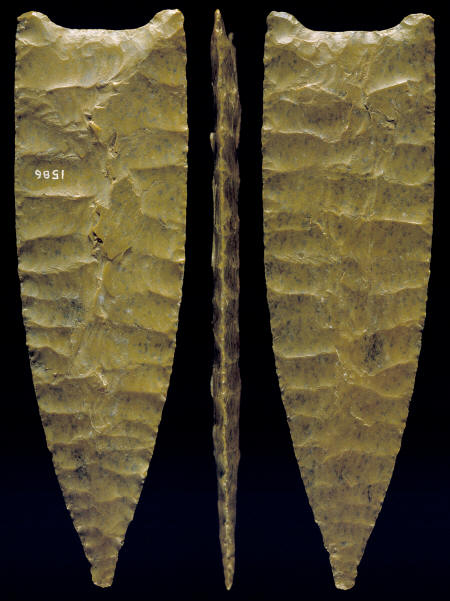
EPOXY CAST OF A GOSHEN POINT
FROM THE MILL IRON SITE
CLICK ON PICTURE FOR LARGER IMAGE
GOSHEN POINT
MILL
IRON
SITE
CARTER COUNTY, MONTANA
This is
the best example of a Goshen point found on the Mill Iron site. It
was discovered in the bone bed area. This point is so exceptionally
well made that it caused some speculation as to weather it was even
used as a projectile point. Frison writes that, "Could it have been
a ritual offering instead of a weapon used to kill animals?"
This Goshen point exhibits the highest knapping skill that
Paleo-Indians ever produced. It's also interesting for the rounded
point. Unlike most Goshen points that have sharp points, the tip of
this one was deliberately shaped with micro flaking into a rounded
point. Frison also writes that "The question was raised at Mill iron
if one projectile point (the one
illustrated above) was used as a
weapon or an offering for ritual purposes. An argument was
made-----that although the quality of the technology expressed on
this specimen is unexcelled in any known prehistoric flint knapping
context, its morphology is not that of a functional piece of
weaponry needed for killing large animals such as bison. No
archaeologist can dismiss the lessons from ethnological studies
which describe the ritual activities that accompany large animal
procurement." This is the longest projectile point found on the Mill
Iron site. It's believed to be made of Hartville chert and it
measures 3 1/8 inches (8 cm) long. |
|
|
A camp site and a bone bed were discovered on the Mill Iron site.
Both locations were connected with a continuous scattering of bison
bones. The bone bed is not considered to be a kill site but rather a
meat processing site. Frison describes the bone bed as "--a pile of
stacked single bones and articulated carcass parts about 4.5 meters in
diameter." It's suggested that the kill site area may have been destroyed by
erosion. |
|
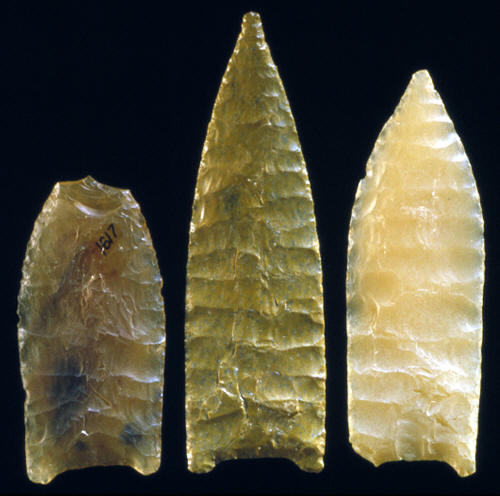
EPOXY CASTS OF GOSHEN POINTS FROM THE
MILL IRON SITE
GOSHEN POINTS
MILL
IRON
SITE
CARTER COUNTY, MONTANA
These three Goshen points were found during excavation of the Mill
Iron site. Their most interesting design trait is
the shape of the basal edges which are straight within the lowest
part of the concavity, similar to some Folsom points. The majority
of the projectile points from Mill Iron have rounded concave bases.
The two points on the right were made with highly controlled
pressure flaking. Frison and Bradley describe the point on the right
as "an exquisite example of highly controlled pressure flaking."
This point was basally thinned with the removal of multiple thinning
flakes from both sides. The cutting edges were straightened and
sharpened with fine pressure retouch flakes that were removed
between the flake scars. This point was made from silicified wood
and it measures 2 3/4 inches (7 cm) long.
The point in the center is considered the best example in the assemblage. It has
been suggested that it was not used to hunt with but instead that it
was an offering for ritual purposes. It was discovered in the bone
bed. It's believed to be made from Hartville chert and it measures 3
1/8 inches (8 cm) long.
The point on the left has a damaged point due to an impact
fracture. It's believed to be made of Montana Agate and it measures
2 1/16 inches (5.3 cm) long. |
|
|
The camp site area produced eleven projectile points and 44
miscellaneous tools in the form of end-scrapers, raclettes, gravers,
bifaces, utilized flakes, and single, double and multiple edged
unifacial tools. The bone bed produced twelve projectile points and
eight miscellaneous tools in the form of bifaces, utilized flakes and
unmodified flakes. |
|
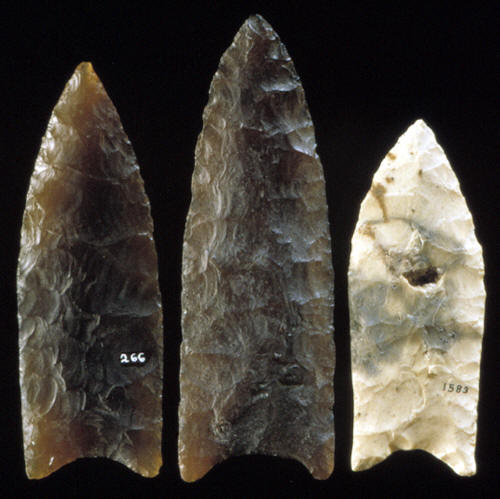
EPOXY CASTS OF GOSHEN POINTS FROM THE
MILL IRON SITE
GOSHEN POINTS
MILL
IRON
SITE
CARTER COUNTY, MONTANA
These three Goshen points represent
more typical examples. The point on the left is described by Frison
and Bradley as a point that, "conforms in shape to the general
description of Goshen points." The hafting area edges on this point
(proximal edges) are straight but expand slightly towards the point
(distal portion). Pressure flaking on both sides was selective with
a wide range of flake scar widths. Pressure flakes on the base are
not large enough to be considered basal thinning. The material is
not identified. This point measures 2 1/2 inches (6.3 cm) long.
The point in the center was found in the bone bed. Its greatest
width is near the base. The ears are rounded and the basal cavity is
ground and the edges are ground half-way up the point. This point
may be made of Hartville chert and it measures 2 13/16 inches (7.1
cm) long.
The point on the right appears to be slightly fish-tailed because
the ears are projected outward. This point has one of the deepest
basal cavities. Its maximum thickness is located towards the point
(distal end). Pressure flaking is described as "irregular in terms
of sequence, spacing, and orientation." Basal thinning is
represented by one flake scar on one side and the basal hafting area
is heavily ground. This point was made from a lower grade piece of
silicified algae which may explain some of its irregular form. This
point measures 2 1/8 inches (5.3 cm) long. |
|
|
The largest stone tool discovered on the Mill Iron site was
found in the main block excavation (camp & bone bed meat processing
area). This tool is described as either a chopper, hammer or anvil
stone. Frison writes that "The tool could have been used in the hand as
a chopper or it could have been partially buried and used as an anvil
over which large bones could have been broken." This tool was made on
site and refit flakes were found near by. Two of its edges were heavily
used. |
|
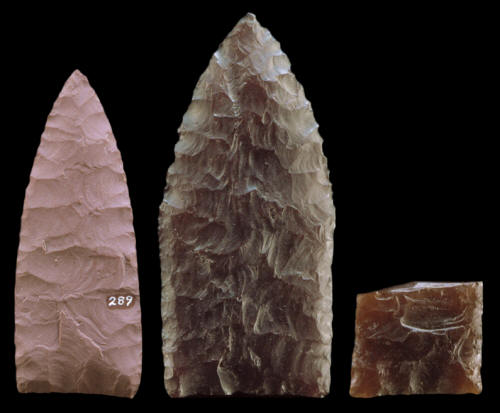
EPOXY CASTS OF GOSHEN POINTS FROM THE
MILL IRON SITE
GOSHEN POINTS
MILL
IRON
SITE
CARTER COUNTY, MONTANA
These three Goshen points are described as atypical in form. Their
bases have only the slightest indentation. The point on the right
represents the only basal fragment found on the site. A large
"flute-like" flake originating from the break indicates that this
point was broken from impact.
The point in the center was found in the bison bone bed. It's
described by Frison & Bradley as being, "in some ways, an
extraordinary point." They believe that it was probably made from
the mid-section of what would have been the largest point in the
assemblage. They also describe it as being flat lens shaped in
cross-section. Pressure flaking scars are shallow and difficult to
distinguish from one another on one side and slightly more distinct
on the other. The edges in the hafting area, on the base and sides,
are steeply retouched with pressure flaking and heavily ground. This
has the effect of making it almost look stemmed. The material was
not identified. It measures 2 3/16 inches (5.5 cm) long.
The point on the left was found in the camp area. It's described as
being nearly triangular in shape with slightly convex sides and that
it may have been made from "the all-over reworking of a piece of a
larger broken point. This point is made of porcellanite and measures
1 7/8 inches (40.7 cm) long. |
|
|
The Mill Iron site produced nine radio carbon dates. Five dates
were obtained from the camp site and four from the bone bed meat
processing area. The radio carbon dates range in time from 10,770 +
85 years to 11,360 + 170 years. The average date from all nine
dates is 11,187 + 222 years. |
|
CONTINUE ON TO PAGE
TWO
|
|
"REFERENCES"
1991,
Frison, George C., "The Goshen Paleoindian Complex: New Data For
Paleoindian Research," Clovis Origins And Adaptations, p.
133.
1996,
Frison, George C., "The Mill Iron Site," p. 205.
1999, Stanford, Dennis, "Paleoindian Archaeology And Late
Pleistocene Environments In The Plains And Southwestern United States,"
Ice Age Peoples Of North America, Environments, Origins, And
Adaptations, pp. 305-310.
2002,
Haynes, Gary,
"The Early Settlement Of North America, The Clovis Era," p.
257.
2006,
Huckell, Bruce B. And Judge, W. James, "Paleo-Indian: Plains And
Southwest," Handbook Of North American Indians, Vol. 3,
Environment, Origins, And Population, p. 158.
2006, Jeb Taylor, "Projectile Points Of The High Plains. New
Perspectives On Typology Based On Examinations Of Original Type Site
Specimens," pp.151-162.
|
|
RECENT
LISTINGS HOME
ORDERING |
